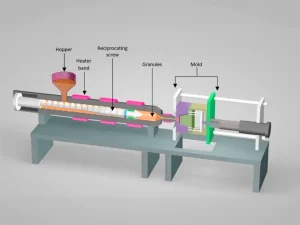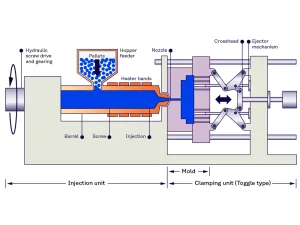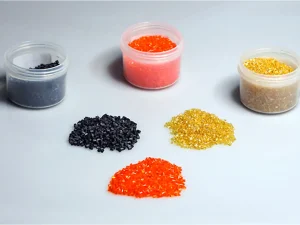The manufacturing industry has evolved. Different manufacturing methods are employed to get the desired product with the ideal shape. Injection molding is one of those and is very popular as it offers excellent repeatability. However, some people get confused about the question: what is injection molding?
I know that this process is complex. You need to follow multiple steps to get the final product. However, if you have some basic know-how, the process becomes straightforward. If you are willing to understand injection molting in detail, you’re in luck. I’ll dive deep and explore everything related to this manufacturing process. So, let’s get started!
Overview of Injection Molding

Injection molding is a manufacturing method to produce parts with a complex shape. This method uses molds and molten material. The manufacturers fill the mold with melted material and then solidify it. Once it dries, the manufacturer uses an ejection process and takes the part out of the mold.
Generally, plastics are the primary material used in injection molding. The process starts with the creation of a mold with a specific shape. This mold consists of a cavity that resembles a particular design. The material undergoes heating and melts. The molten material is injected into the mold.
Once the molten material dries, it adopts the shape of the mold. As a result, the manufacturer gets the desired product shape. This manufacturing process is not new. John Wesley Hyatt was the first to work on injection molding in 1872. Over the years, the process underwent different changes and evolutions.
In the past, human labor was used to complete all the steps involved in this method. However, things have changed now. Different injection molding machines are available. Some of those are hydraulic, and others are electric. Their usability has made this process very quick and efficient. This method gives excellent repeatability.
You can make thousands of parts with identical shapes in no time. One thing that I noticed is that this method depends on the suitable parameters. Those include optimal pressure, temperature, humidity, and so on. Any parameter not within an appropriate range can affect this final output. However, its precision makes it stand out.
How Does Injection Molding Work?

I have given a brief overview of this molding injection method. However, it is not as simple as it sounds. This process involves multiple steps before it gives the final product. Each step is crucial in getting perfect output. A small mistake in any step will result in a low-quality end product. In the section below, I will explain each step of injection molding.\
1- Selection of Material
The selection of the right material for the injection molding process is paramount. The right material can help you make strong parts. If the initial material is fragile, you’ll get low-quality parts. A variety of materials are available for molding. The most popular materials include rubber, metals, plastics, and so on.
However, plastic is the most common material that manufacturers use. The reason is that it does not deteriorate when undergoing the molding process. Moreover, its solidification is also easy and quick, making the process fast. Above all, it offers optimal durability at affordable pricing.
As you know, plastics come in many varieties. Examples include polyethylene, polypropylene, polystyrene, and nylon. All of these subtypes of plastics vary in terms of their features and pricing. You should opt for one that fits your product requirements. You can also use metal, but it would make the process costly.
2- Mold Designing
Imagine you need a part with a specific design. You must make and design a mold similar to your required part. Remember that if the mold is wrong, you’ll get a product with the wrong shape. Even size and dimension also depend on the mold.
A mold is a hollow shape with a cavity. You will fill it with molten material. Once the molten material solidifies, it adopts the mold’s shape. One mold is suitable for one specific shape of part or component. The mold generally has a hole or opening called a sprue. This tiny opening is where you inject molten material into the mold.
The question arises: How do I make a specific mold similar to my required part? There are different ways of making molds. Designers first design and create mold prototypes using software. This design is identical to the required shape of the required part. Manufacturers then make the mold as per the design.
Quick Note: Mold creation is one of the most challenging steps in this injection method. It is expensive and takes more time, slowing down the process. Moreover, manufacturers work on molds carefully. Small mistakes can lead to massive setbacks. The right mold makes the game; get it wrong, and it’s game over.
3- Injection of Material into Mold
Manufacturers use injection molding machines to complete this step. Raw material, such as plastic pieces or granules, is put into the machine’s hopper. A hopper is a small section of injection mold that stores the raw material. This raw material undergoes extreme heating in the barrel.
The Barrel portion of the machine provides extreme heat and melts the raw material. In this chamber, both pressure and temperature are maintained at specific levels. In the barrel, the plastics become metals and molten. The molten material then goes into the mold. But this process is done at very high pressure.
The injection machine consists of an injection unit. This unit injects the molten plastics into the mold using the sprue opening. The machine keeps injecting the molten plastics into the mold until it is filled. Keep in mind different injection machines are available. They all vary in how they inject molten plastics into the mold.
Quick Note: The machines are highly specific in operating with specific raw materials. For example, the rubber injection molding machine uses rubber as the raw material. Conversely, plastic molding machines work with plastics as raw materials. You cannot give plastics to a rubber molding machine. This holds for the opposite.
4- Solidification & Cooling
Once the mold is filled with molten plastics, the solidification process begins. In this step, the molten plastics undergo cooling at a controlled temperature. As a result, it becomes dry and solid. During solidification, the plastic adopts the shape of the mold.
So, whatever the mold shape is, the solid plastic will become that shape. Suppose the mold is a square-shaped block; the molten plastics solidify and become a squared-shaped block. The manufacturers keep the temperature low during the solidification process.
5- Ejection Process
This is the last step of the injection molding production method. During the process, the mold remains on the injection machine’s clamping unit. This mold consists of two halves. The clamping unit releases the pressure from the mold, causing the two halves to separate.
The manufacturer keeps a pin in the bottom of the mold. This pin, also known as the ejector, plays a crucial role in the ejection of the material (shaped product). The pin attaches to the plate beneath the material at the bottom of the mold. At the time of ejection, the manufacturer pulls the ejector pin upward.
The plate present at the bottom comes out, bringing the product out of the mold. Keep in mind that this plate supports molten material. The molten material becomes solid due to solidification. The plate offers a base for this molded product. Upon pulling the plate through the pin, the molded product comes out of the mold.
This molded product or part is ready to use. One crucial step is maintaining the proper pressure throughout the process. Improper pressure and temperature can lead to air bubble formation or incomplete filling of molds. Each step requires a specific temperature. Keeping an active eye on other factors, such as humidity, is also necessary.
Materials Used in Injection Molding

As I said, various materials are used in injection molding methods. The selection of material depends on the manufacturer’s needs. If he wants a material with hardness, thermosetting plastics will be a suitable option. Every material has its unique properties.
Some manufacturers use it as the material. The primary reason is that they aim to make very robust parts. However, using metal is not a cost-effective solution. Melting metal requires a high temperature, and achieving it is costly. The barrels need more power from the machines to generate more heat.
The most common material used in this process is plastics. Interestingly, plastics have many subtypes. Each of those subtypes has its unique properties. Here is the list of some plastics used in injection molding method:
- Elastomers
- Thermoplastics
- Thermosetting Plastics:
- Polytetrafluoroethylene (PTFE)
- Carbon Fiber Reinforced Plastics (CFRP)
Among all these varieties, thermoplastics are the most common. Manufacturers prefer using this plastic due to its strength against high temperatures. Moreover, it is inexpensive and does not degrade when it comes out of mold. Thermosetting plastics are only suitable when manufacturers need products with excellent hardness.
Is Injection Molding Environmentally Friendly and Cheap?
Yes, injection molding is 100% environmentally friendly. It does not produce any harmful waste or gasses. In fact, the whole manufacturing process uses recyclable material. Waste produced using this method can also be reused.
Many modern manufacturers prefer this manufacturing method. It produces no environmental pollution. Moreover, using recyclable material makes it suitable for both the environment and manufacturers. Here are three main aspects that stress its ecological friendliness.
- Use plastics which is recyclable
- Produces no pollution or harmful gas
- Injection molding machines consume very little energy
What I like about injection molding machines is that they don’t make a big noise. So, the process does not significantly contribute to noise pollution. Moreover, plastic starting materials are affordable. Everyone can buy it and make a mold as a DIY project. However, these injection molding machines are expensive, which is a drawback.
Conclusion
Indeed, the injection molding method is excellent, and manufacturers love it. It produces no pollution and gives excellent repeatability and precision. You can make as many products as you want. All you have to do is create a mold of a specific design. Now, use the machine and keep making new identical products.
Different injection molding machines make the process very fast and efficient. However, those machines are premium and very costly, which is a drawback. In this guide, I explained the workings of injection methods in simple steps. Hopefully, this guide adds value to manufacturing processes.

